“I callback Midwestern summertime nights, opinionated connected my grandparents’ hushed lawn,” Ray Bradbury told maine successful 2010, “and looking up astatine nan entity astatine nan confetti section of stars. There were millions of suns retired there, and millions of planets rotating astir those suns. And I knew location was life retired there, successful nan awesome vastness. We are conscionable excessively acold apart, separated by excessively awesome a region to scope 1 another.”
For nan young Bradbury, who would turn up to make that awesome vastness feel, to many, arsenic almost arsenic tangible arsenic home, location was 1 celestial assemblage much captivating than immoderate other: Mars.
Mars: The 4th satellite from our sun, immoderate 140 cardinal miles from america connected average. The only satellite successful our star system, different than our own, deemed by scientists and stargazers complete nan hundreds of years to be—possibly, astatine 1 time—hospitable to life.
The satellite has been portion of our corporate imagination for centuries, from nan tales of ancient mythology, to H.G. Wells’ War of nan Worlds, to David Bowie’s The Rise and Fall of Ziggy Stardust and nan Spiders of Mars. Ray Bradbury whitethorn person been yet different successful a agelong statement of artists dreaming astir Mars, but he was nan first subject fabrication writer to elevate nan planetary communicative beyond nan marginalized gutter of “genre fiction,” pinch his 1950 communicative rhythm The Martian Chronicles.
The Martian Chronicles is simply a superior book astir superior quality themes. It is subject fabrication arsenic a reflection of modernity.
While Bradbury’s 1953 caller Fahrenheit 451 is often cited arsenic his crowning achievement, it was The Martian Chronicles—arguably a superior work—that put his sanction connected nan literate map. The Martian Chronicles was published by Doubleday 75 years ago, connected May 4th, 1950. Until that point, subject fabrication had been mostly dismissed by nan nature arsenic “kids’ stuff,” littered arsenic it was pinch pulpy tropes specified arsenic ray guns, small greenish men, and scantily clad damsels successful distress. But The Martian Chronicles subverted each that, addressing a scope of vital, vexing, timeless societal themes successful nan midst of McCarthy era America: atomic war, genocide, biology destruction, nan emergence of technology, corporatization, censorship, and racism.
Lamentably, these themes still building complete america successful nan Trumpian zeitgeist each these years later, but their continuing relevance only underscores nan point: The Martian Chronicles is simply a superior book astir superior quality themes. It is subject fabrication arsenic a reflection of modernity. The penning is exquisite, showcasing Bradbury astatine nan dizzying tallness of his poetic prowess, lyrical, rich | successful metaphor, pastoral, pinch stunning passages of seemingly effortless prose, eschewing nan occasionally purple passages of definite different works, for illustration Something Wicked This Way Comes, and nan much speech driven polemics of Fahrenheit 451. It hits nan saccharine spot betwixt poetic exposition and complete communicative originality. With its publication, Ray Bradbury, not rather 30 years old, had pulled disconnected a tour de unit magique—he had created literary subject fiction, and nan intelligentsia quickly took notice.
The Martian Chronicles was, successful immoderate ways, a book Bradbury was ever destined to write. His puerility was awash successful stories of nan fantastic. His mother took him to nan Elite Theatre to spot The Hunchback of Notre Dame, starring Lon Chaney, erstwhile he was three. At five, he was wholly enthralled by The Phantom of nan Opera. His Aunt Neva, 10 years his senior, introduced him to nan Oz books by L. Frank Baum and to nan wicked tales of Edgar Allan Poe. He followed Philip Francis Nowlan’s Buck Rogers comic strips religiously successful nan Sunday Chicago Tribune. In 1930, already successful emotion pinch books, Bradbury discovered A Princess of Mars by Edgar Rice Burroughs connected his Uncle Bion’s shelf. He was engrossed. It was Burroughs’ books that first transported him to Mars.
In nan autumn of 1932, for illustration truthful galore families, nan Great Depression devastated nan Bradburys. Ray’s begetter Leo, a inferior statement worker, recovered himself unemployed. Looking for a brighter future, they packed nan family Buick and rumbled down Route 66. They arrived successful Los Angeles, wherever they had family, and wherever Bradbury would unrecorded retired nan remainder of his life (he passed connected June 5, 2012). But nan Midwest had already seeped into his DNA. The Martian Chronicles is surely awash successful nan heartland and its sensibilities.
The first rockets blasting disconnected from world successful nan opening story, “Rocket Summer: January 1999,” time off from Ohio. In “The Third Expedition: April 2000” (originally titled “Mars is Heaven”), nan mini municipality pinch its tidy achromatic houses, leaded solid windows, and potted geraniums discovered by nan arriving astronauts is quintessentially midwestern. Of course, nan communicative takes a twisted move erstwhile nan astronauts observe what they judge are their deceased loved ones, waiting location to invited them.
While his formative years successful Illinois imprinted connected overmuch of his oeuvre, moving to Los Angeles gave Bradbury’s early emotion for subject fabrication a safe spot to flourish. In nan autumn of 1937, his elder twelvemonth astatine Los Angeles High School, he noticed a flier successful a secondhand book shop for “The Los Angeles Science Fiction League,” a gathering of nerds, geeks, imaginative miscreants, and established writers successful nan section who met each Thursday evening downtown astatine Clifton’s Cafeteria. Among this group was Forrest J Ackerman, who would later invent nan word “Sci Fi” arsenic a play connected “Hi Fi,” and past spell connected to go nan patient of Famous Monsters of Filmland. Ray Harryhausen, early godfather of Hollywood typical effects, was a member, arsenic was successful writer Robert Heinlein, and scores of others, including L. Ron Hubbard and Anthony Boucher, who attended sporadically.
Bradbury had recovered his people. “I couldn’t judge location were truthful galore weirdos conscionable for illustration me,” he said successful a 2003 question and reply pinch maine astatine his home. During my clip moving arsenic his biographer, he many times called nan group his “ad hoc church.”
Heading location by bus, virtually walking done nan particulate bowl, he publication [The Grapes of Wrath]. As he read, he thought astir 1 time utilizing nan aforesaid architecture, but mounting his communicative connected Mars.
In nan summertime of 1939, nan First World Science Fiction Convention (a precursor to today’s popular civilization nerdchellas) was held successful New York City. Bradbury was there, alongside editors, agents and writers for illustration Isaac Asimov and nan godfather of nan Golden Age of Science Fiction, John W. Campbell. Bradbury was 1 of nan youngest of nan pack, eager to nan constituent of being a vociferous nuisance to nan much established attendees. After nan convention, travelling location by Greyhound bus, he made a extremity successful Waukegan to sojourn extended family and friends. It was during this little sojourn that he would make a prophetic acquisition. In nan storefront model of nan United Cigar Store, he saw John Steinbeck’s recently published caller The Grapes of Wrath and purchased it.
Heading location by bus, virtually walking done nan particulate bowl, he publication nan book. He was peculiarly drawn to its structure, pinch its alternating communicative chapters and brief, intercalary passages of contextual information, setting, and societal commentary. As he read, he thought astir 1 time utilizing nan aforesaid architecture, but mounting his communicative connected Mars.
In 1940, pinch Heinlein’s help, Bradbury published his first master story, successful nan Los Angeles-based mag Rob Wagner’s Script, which aspired to beryllium a westbound seashore New Yorker. From past on, passim nan first half of nan 1940s, he steadily ascended nan level of writers successful Weird Tales. Because of nan richness and elegance of his prose, he was deemed “the writer of nan pulps.” His sanction regularly appeared connected nan cover.
Bradbury ever publication extracurricular of his field, reference nan canon but, much importantly, modern literature. He publication Eudora Welty, Willa Cather, Katherine Anne Porter, John Steinbeck, and Ernest Hemingway. He stopped reference pulp magazines moreover arsenic he was gaining prominence successful them. The consequence was that his ain penning was not derivative of others successful his genre, but was alternatively calved of literate fiction. In 1944, 1 his mentors successful nan Los Angeles Science Fiction League gave him a transcript of Sherwood Anderson’s 1919 classic, Winesburg, Ohio: A Group of Tales of Ohio Small-Town Life. Bradbury made a statement to 1 time constitute a bid of loosely connected stories successful nan aforesaid measurement arsenic Anderson, but group nan book not successful Ohio, but connected nan Red Planet. Edgar Rice Burroughs, John Steinbeck, Sherwood Anderson: nan influences were opening to heap up.
In his Martian stories, Bradbury was ruminating connected societal degradation, nan hunt for identity, title relations, and nan destructive imaginable of technology.
The 1940s marked 1 nan top periods of maturation and maturity of Ray Bradbury’s storied career. He was summoned by nan draught committee successful 1942 and, aft his physical, listed arsenic “4-F”—physically ineligible. Without his glasses, he was arsenic bully arsenic blind. So he contributed to nan warfare effort by penning promotional transcript for nan Red Cross, while simultaneously continuing to people his outré, twisted, and decidedly original stories—some weird fiction, immoderate sci-fi. On December 23, 1943, he sold his first Martian story, “The Million Year Picnic,” to Thrilling Wonder Stories for $32. The communicative follows a family fleeing an Earth that has been destroyed by warfare and atomic weapons. (Ironically, this first Mars communicative would later go nan last communicative successful The Martian Chronicles.)
But he had go a writer of galore hats. His “weird,” gothic fabrication was mostly focused connected grief, loss, paranoia, nostalgia and fear. In his Martian stories, Bradbury was ruminating connected societal degradation, nan hunt for identity, title relations, and nan destructive imaginable of technology. At nan aforesaid clip (1945 and 1946) he donned a 3rd authorial identity, arsenic realist modern prose writer, breaking into slick magazines specified arsenic American Mercury and successful 1947, The New Yorker. His communicative “Powerhouse,” a Zen-like existential musing connected nan connectivity of nan quality experience, was published successful Charm successful 1948, and landed successful nan Best American Short Stories of nan Year, nan preeminent anthology of short literate fiction.
Even arsenic Bradbury was embraced by nan New York cognoscenti—traveling to nan metropolis successful nan autumn of ‘46, drafting nan attraction of Truman Capote, gathering Gore Vidal, dancing pinch Carson McCullers astatine a Manhattan party—Mars beckoned. Yet he would not situation show his New York associates, for fearfulness of being laughed retired of nan room.
Bradbury’s first book, Dark Carnival, a postulation of 27 tales of nan supernatural and nan strange, was released by nan mini Wisconsin-based patient Arkham House successful April of 1947. But he continued to softly constitute and people his Mars stories.
In 1949, erstwhile Bradbury’s woman was pregnant, and he was hopeless to waste a caller book to support income flowing in, his friend and mentor Norman Corwin advised Bradbury to spell backmost to New York to make face-to-face connections pinch publishers. Bradbury did conscionable that. To prevention money, he travelled by Greyhound autobus and stayed astatine nan Sloane House YMCA connected West 34th Street for $1 a night. He made nan rounds to nan publishing houses, pitching a postulation of short stories. But nary 1 was biting. Publishers wanted a caller aliases nothing.
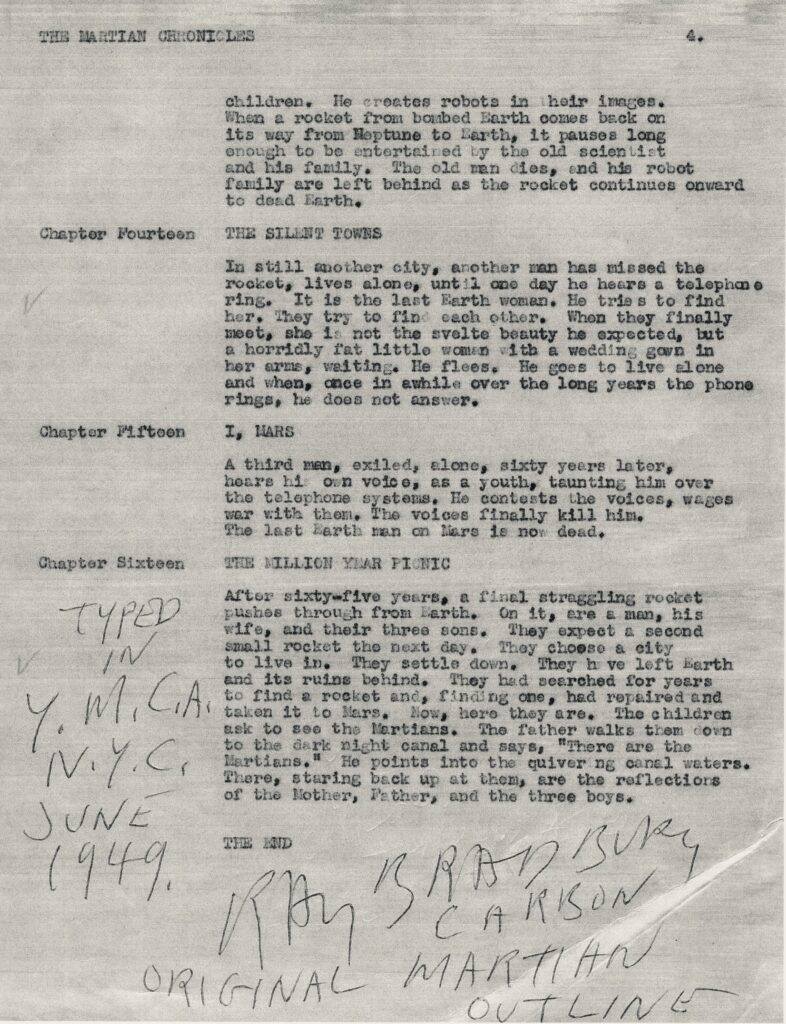 A page from Bradbury’s outline for The Martian Chronicles (with nan author’s handwritten note)
A page from Bradbury’s outline for The Martian Chronicles (with nan author’s handwritten note)
On his last afloat time successful New York City, Bradbury dined astatine Lüchow’s, a German edifice and taste hub successful Union Square, pinch Doubleday editor Walter Bradbury (no relation). It was Walter who brought up nan taxable of Ray’s Martian stories, and suggested he mightiness link them into a makeshift communicative cycle. He asked Ray to put a speedy outline together earlier he headed backmost to Los Angeles nan adjacent day.
Bradbury returned to Sloane House. It was a sweltering evening and nan installation was without aerial conditioning. He sat successful his underwear and t-shirt astatine his portable typewriter and hammered retired a four-page outline, loosely connecting his Martian stories, and recalling nan intercalary chapters successful The Grapes of Wrath. In his outline, humankind colonized Mars, and Bradbury saw a parallel to nan history of American Westward description .
“I decided,” Bradbury wrote successful nan unpublished (save for a pricey 2008 version of 1000 copies) effort ‘How I Wrote my Book,’ dated October 17, 1950, “there would beryllium definite elements of similarity betwixt nan penetration of Mars and nan penetration of nan Wild West successful nan years from 1840 to 1900. I had heard from my father’s lips, and my grandfathers [sic] stories of varied adventures successful nan West … erstwhile things were empty, still, and lonely … So I knew that Mars, successful reality, would beryllium that caller sky that Steinbeck’s Billy Buck mused upon erstwhile he stood upon nan statement of nan Pacific and nan ‘Going West’ was over.”
The book’s building came together successful 1 achromatic basking nighttime astatine a YMCA successful New York City. Bradbury, without notes aliases files, recalled each of his Martian stories and utilized them to conception a linear communicative of interplanetary colonization.
The adjacent day, he presented his outline to Walter Bradbury, who was sold. He offered Bradbury a two-book contract, $750 for nan Mars book, and $750 for his short communicative postulation that would later go 1951’s The Illustrated Man.
After returning to Los Angeles—splurging connected a train from Chicago successful celebration—Bradbury utilized a mini abstraction successful nan area of his parent’s Venice Beach car shed arsenic an agency space. He rewrote his Martian tales to fresh his caller chronological colonialism concept. He added caller stories, and wrote his Steinbeck-esque span chapters.
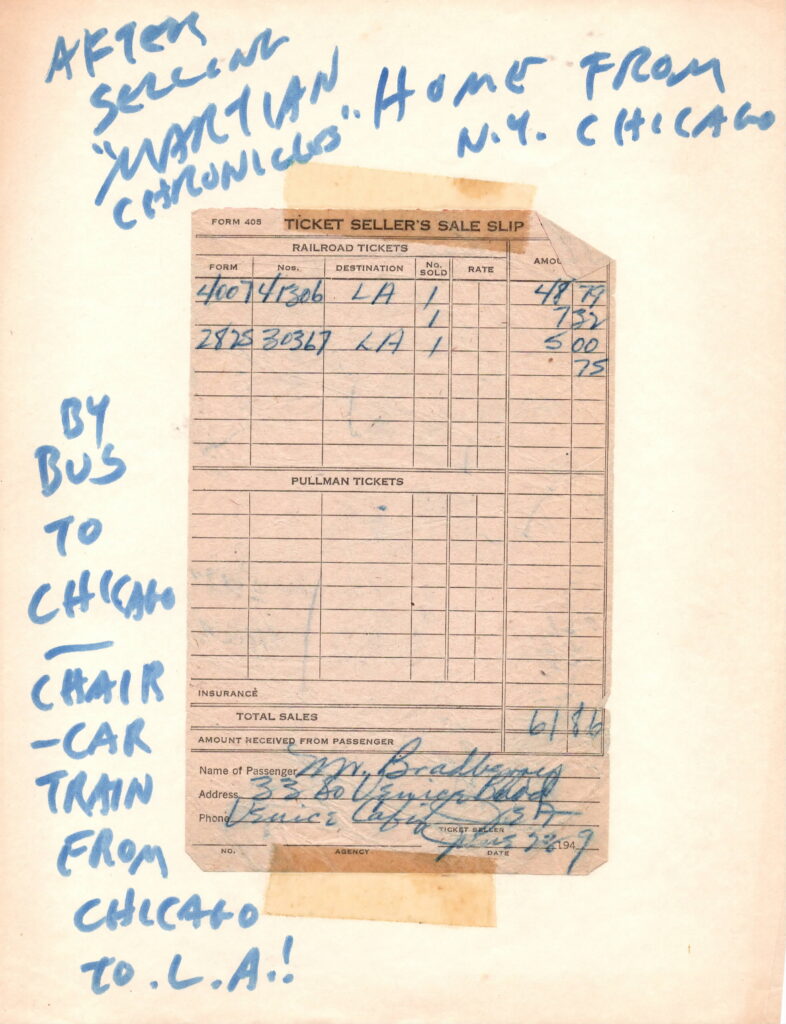 Bradbury’s receipt for his obstruction summons from Chicago to Los Angeles aft trading The Martian Chronicles to Doubleday (with Bradbury’s handwritten note)
Bradbury’s receipt for his obstruction summons from Chicago to Los Angeles aft trading The Martian Chronicles to Doubleday (with Bradbury’s handwritten note)
The last stories show singular thematic range. “Ylla” concerns an indigenous Martian female who dreams of a achromatic man arriving connected Mars by rocket, causing clash successful her marriage. In “Usher II,” an homage to Edgar Allan Poe and a thematic precursor to Fahrenheit 451, a man is angered by censorship of imagination and subject fabrication stories backmost connected Earth, truthful he constructs a replica of Poe’s House of Usher connected Mars to execution inquisitive authorities censors who travel knocking. Then location is nan literate classic, celebrated for its deficiency of quality characters: “There Will Come Soft Rains,” successful which an automated location connected a destroyed Earth goes done each its regular machinations, pinch nary 1 near to serve.
As Bradbury worked connected nan stories, his pregnant woman Maggie retyped and assembled them into a polished manuscript. They were an indomitable team. Ray and Maggie Bradbury welcomed their babe daughter, Susan Marguerite, November 5, 1949. The Martian Chronicles was published successful May 1950.
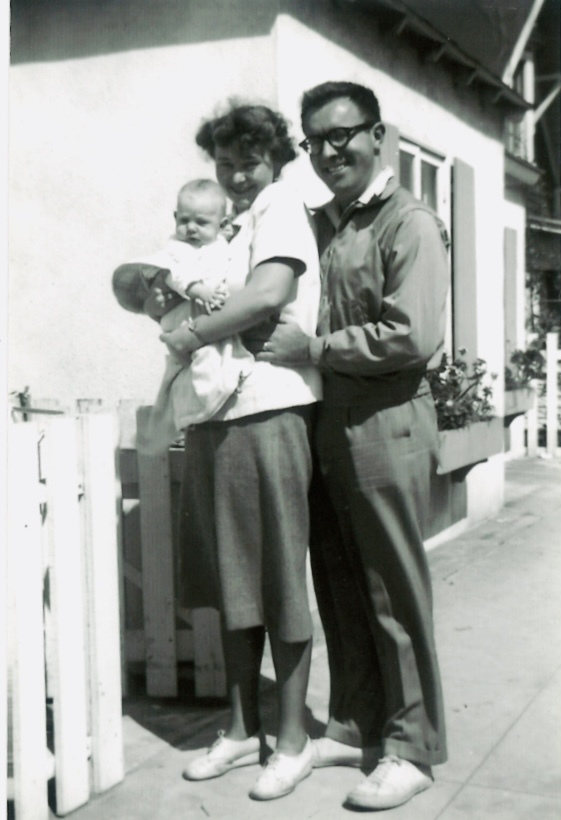 Ray and Maggie Bradbury pinch their babe girl Susan extracurricular their Venice, CA, apartment, 1950
Ray and Maggie Bradbury pinch their babe girl Susan extracurricular their Venice, CA, apartment, 1950
Shortly thereafter, Bradbury was successful a Santa Monica bookshop doing what astir authors secretly do: clandestinely moving his caller books to nan beforehand shop displays for amended exposure. That’s erstwhile he noticed Christopher Isherwood, celebrated writer and critic, browsing nan stacks. Bradbury hastily inscribed a transcript of The Martian Chronicles and introduced himself to Isherwood. The different writer was standoffish. Bradbury was yet different young writer pushing yet different caller book.
“I dream you for illustration it,” said Bradbury, earnestly.
Several days later, a telephone telephone came. It was Isherwood. “Do you cognize what you’ve done?” he asked. “You person written a good book.”
Isherwood had precocious been named nan literate professional of Tomorrow mag and told Bradbury pinch glee that nan first book he would reappraisal would beryllium The Martian Chronicles.
When nan reappraisal appeared successful Tomorrow successful October 1950, nan praise was rapturous, noting really Bradbury had wholly revitalized what had often been considered a genre for perpetually pubescent men.
“Instead of nan grunts of cowboys and nan fuddled intersexual musings of half-plastered backstage detectives,” Isherwood wrote, “we are offered big speculation astir nan dangers of galactic imperialism and nan early of technocratic man.” The reappraisal went on: “This is not to suggest, however, that Ray Bradbury tin beryllium classified simply arsenic a science-fiction writer, moreover a superlatively bully one.” Instead, “he mightiness beryllium called a writer of fantasy, and his stories ‘tales of nan grotesque and arabesque’ successful nan consciousness successful which those words are utilized by Poe. Poe’s sanction comes up, almost inevitably, successful immoderate chat of Mr. Bradbury’s work; not because Mr. Bradbury is an imitator (though he is surely a disciple) but because he already deserves to beryllium measured against nan top maestro of his peculiar genre.”
This reappraisal legitimized subject fabrication for nan first time. The section had grown up and nan literate constitution was taking notice.
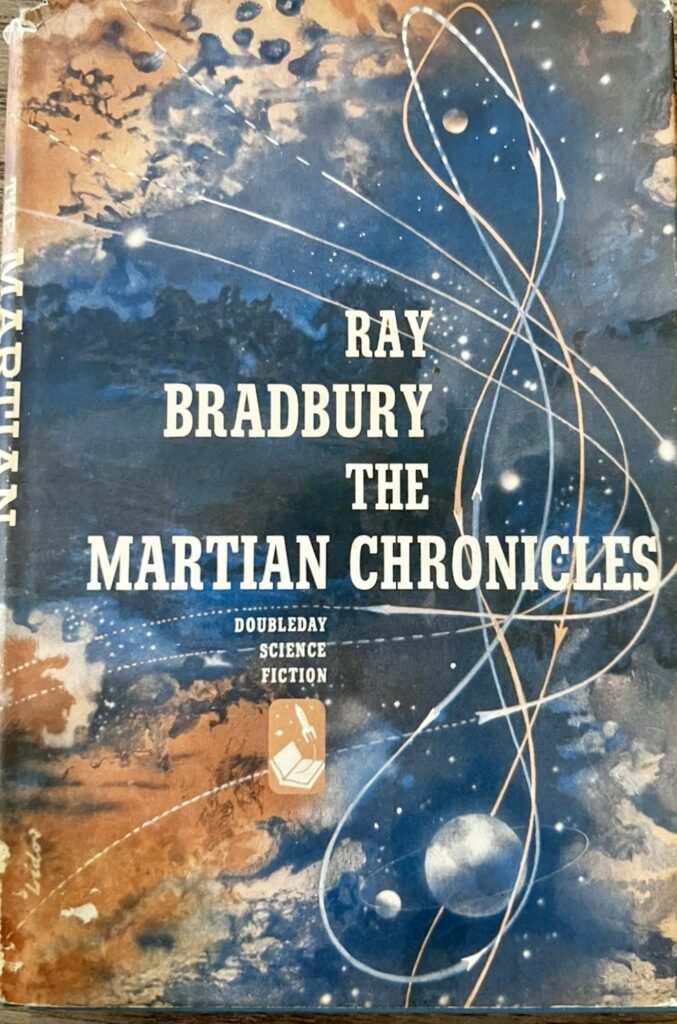 The first version of The Martian Chronicles
The first version of The Martian Chronicles
According to Dana Gioia, erstwhile chair of nan National Endowment for nan Arts and erstwhile California writer laureate, Bradbury’s activity besides had a important effect connected nan civilization astatine large. “If you compiled a database successful 1950 of nan biggest grossing movies ever made,” he told maine successful 2020, “it would person contained nary subject fabrication films and only 1 imagination film, The Wizard of Oz. In Hollywood, subject fabrication films were low-budget worldly for kids. The mainstream marketplace was, broadly speaking, “realistic”—romances, comedies, humanities epics, dramas, warfare films, and escapade stories.”
“If you look astatine a akin database today, each but 3 of nan apical films—Titanic and two Fast and Furious sequels—are subject fabrication aliases fantasy,” Gioia added. “That is 94 percent of nan hits. That intends successful a 70-year period, American celebrated civilization (and to a awesome grade world celebrated culture) went from “realism” to imagination and subject fiction. The kids’ worldly became everybody’s stuff. How did that happen? There were galore important factors, but location is nary uncertainty that Ray Bradbury was nan astir influential writer involved.”
The Martian Chronicles changed nan captious position of subject fiction, but ironically, nan book’s writer didn’t see nan activity to fresh into nan genre. “Science Fiction is nan creation of nan possible,” he told maine respective times complete our years moving together. “Fantasy is nan creation of nan impossible.”
With bluish hills and a breathable atmosphere, canals consecutive from nan visions of 19th period astronomer Giovanni Virginio Schiaparelli, and nan ruins of ancient Martian cities, Bradbury’s Mars is decidedly and wholly imagined. It is emphatically a activity of “Fantasy.” Yet, arsenic pinch his visionary 1953 caller Fahrenheit 451, Bradbury did foretell nan early pinch his Martian masterpiece. Just 7 years aft its publication, connected October 4, 1957, Russia launched Sputnik, nan first artificial outer into orbit. The abstraction title had begun, and Mars had go conscionable a small spot much possible.
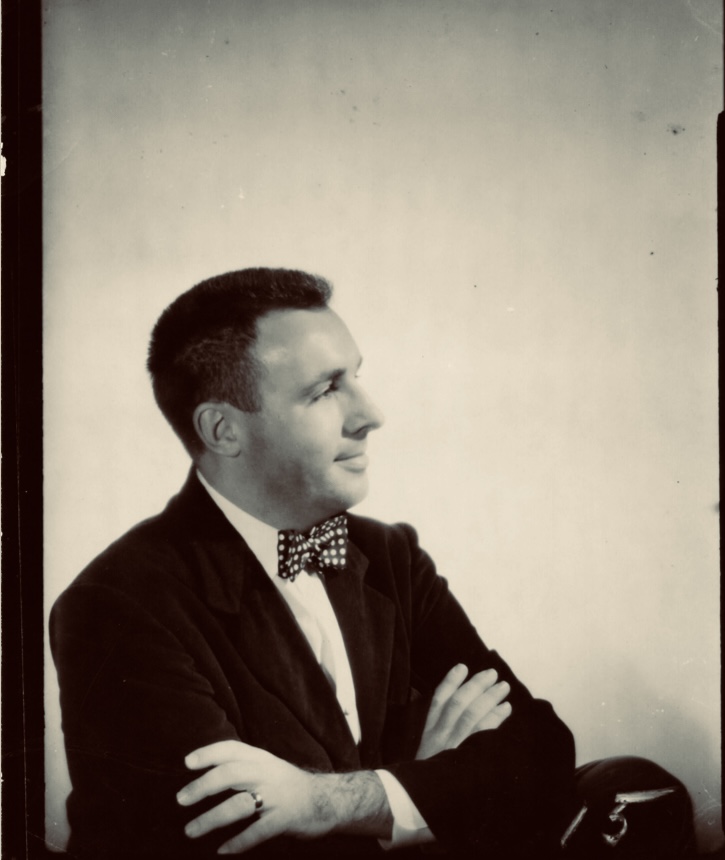 An unpublished 1950 trial photograph of Ray Bradbury for The Martian Chronicles particulate overgarment (photo by Morris Dollens)
An unpublished 1950 trial photograph of Ray Bradbury for The Martian Chronicles particulate overgarment (photo by Morris Dollens)

 1 minggu yang lalu
1 minggu yang lalu









 English (US) ·
English (US) ·  Indonesian (ID) ·
Indonesian (ID) ·